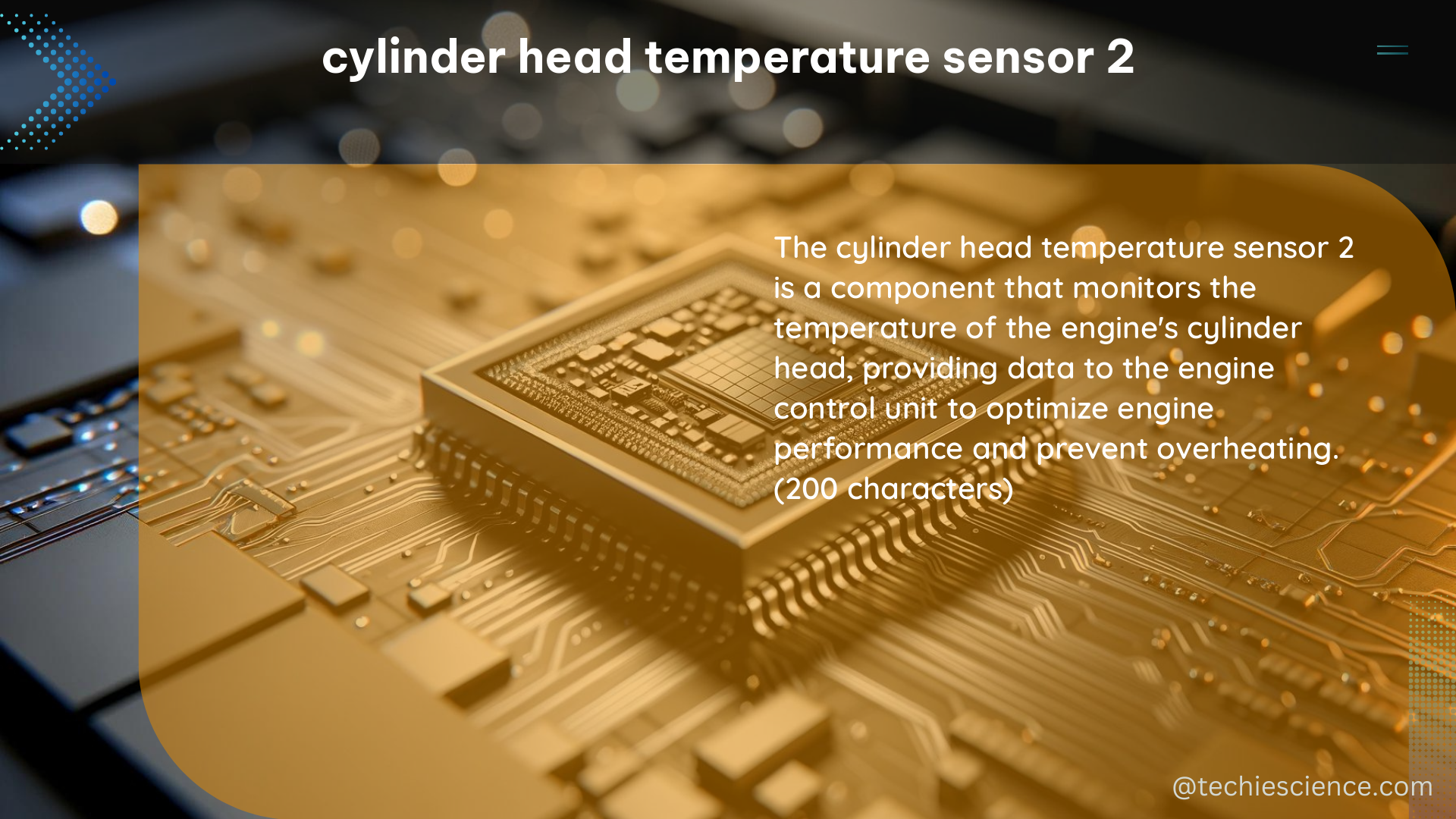The cylinder head temperature sensor 2 is a critical component in modern internal combustion engines, providing real-time temperature data for engine management systems to optimize performance, fuel efficiency, and emissions. This sensor is typically located in the engine’s cylinder head, where it measures the temperature of the coolant flowing through the engine, allowing the engine control unit (ECU) to make adjustments to various engine parameters for optimal operation.
Technical Specifications of Cylinder Head Temperature Sensor 2
To understand the measurable, quantifiable data associated with the cylinder head temperature sensor 2, we must examine its technical specifications in detail.
Temperature Range
The cylinder head temperature sensor 2 is designed to operate within a specific temperature range, typically from -40°C to 150°C (-40°F to 302°F). This wide range ensures accurate temperature measurement under various operating conditions, from cold starts to high-load, high-temperature scenarios. Some advanced sensors may even have an extended temperature range of -55°C to 200°C (-67°F to 392°F) to accommodate extreme operating environments.
Accuracy
The accuracy of the cylinder head temperature sensor 2 is usually specified as a tolerance within a certain temperature range. For example, the sensor may have an accuracy of ±2°C (±3.6°F) within the range of -40°C to 150°C (-40°F to 302°F). Higher-end sensors can achieve even greater accuracy, with tolerances as low as ±1°C (±1.8°F) in the same temperature range.
Response Time
The response time of the cylinder head temperature sensor 2 refers to the time it takes for the sensor to provide an accurate temperature reading after a change in temperature. A typical response time for this type of sensor is around 100 milliseconds, but some advanced sensors can achieve response times as low as 50 milliseconds, allowing for faster engine management adjustments.
Compatibility
The cylinder head temperature sensor 2 must be compatible with the engine management system it is connected to. This compatibility ensures accurate data transmission and interpretation by the ECU, which is crucial for optimizing engine performance, fuel efficiency, and emissions. Sensor manufacturers often provide detailed information on the specific engine management systems their products are compatible with.
Environmental Factors Affecting Cylinder Head Temperature Sensor 2 Performance

In addition to the technical specifications, the cylinder head temperature sensor 2 is subject to various environmental factors that can affect its performance. These factors include:
- Temperature Range: The sensor must be able to withstand the full range of operating temperatures, from cold starts to high-load, high-temperature conditions.
- Package Size: The sensor’s physical size and form factor must be compatible with the engine’s design and installation requirements.
- Thermal Response Time: The sensor must have a fast thermal response time to accurately capture rapid temperature changes in the engine.
- Electrical Response Time: The sensor’s electrical response time must be fast enough to provide real-time temperature data to the engine management system.
- Heat Sinking: The sensor must be designed to effectively dissipate heat, ensuring accurate temperature measurements.
- Thermal Mass: The sensor’s thermal mass should be small to minimize the impact on temperature measurements.
- Robustness: The sensor must be able to withstand the harsh environment of the engine, including vibrations, shocks, and thermal cycling.
- Compatibility with Harsh Environments: The sensor must be able to operate reliably in the presence of magnetic fields, ionizing radiation, ultra-high vacuum, and other challenging environmental conditions.
- Signal Quality: The sensor must provide an easily measured signal with minimal interference from sources of error, such as thermal EMFs, self-heating, and noise pickup.
- Sensitivity and Accuracy: The sensor must have high sensitivity and accuracy, with high repeatability both in the short and long term.
- Power Dissipation: The sensor’s power dissipation should be low to minimize its impact on the engine’s electrical system.
- Interchangeability: The sensor should be easily interchangeable with other compatible models, simplifying maintenance and replacement.
- Ease of Use: The sensor should be designed for easy installation and integration with the engine management system.
- Cost and Availability: The sensor should be cost-effective and readily available to ensure widespread adoption and support.
Selecting the Right Cylinder Head Temperature Sensor 2
When selecting a cylinder head temperature sensor 2 for a specific application, it is essential to consider the technical specifications and environmental factors that are most important for the intended use. For example, a high-performance engine may require a sensor with exceptional accuracy, fast response time, and compatibility with advanced engine management systems, while a more cost-sensitive application may prioritize robustness, ease of use, and lower cost.
By understanding the measurable, quantifiable data associated with the cylinder head temperature sensor 2, including its technical specifications and environmental factors, you can make an informed decision and select the right sensor for your specific needs. This knowledge will help ensure optimal engine performance, fuel efficiency, and emissions, while also simplifying maintenance and reducing the risk of costly failures.
References
- Emerson: CONTROL VALVE HANDBOOK | Emerson
- ADS-51-HDBK: 1996-10-21 AVIATION RESEARCH AND DEVELOPMENT CENTER DIRECTORATE FOR ENGINEERING
- Temperature Measurement and Control Catalog: Lake Shore Cryotronics, Inc.
- What Is The In Cylinder IAT Drop With e85?: ModularFords.com
- GUIDELINES FOR SAMPLING: NC.GOV

The lambdageeks.com Core SME Team is a group of experienced subject matter experts from diverse scientific and technical fields including Physics, Chemistry, Technology,Electronics & Electrical Engineering, Automotive, Mechanical Engineering. Our team collaborates to create high-quality, well-researched articles on a wide range of science and technology topics for the lambdageeks.com website.
All Our Senior SME are having more than 7 Years of experience in the respective fields . They are either Working Industry Professionals or assocaited With different Universities. Refer Our Authors Page to get to know About our Core SMEs.